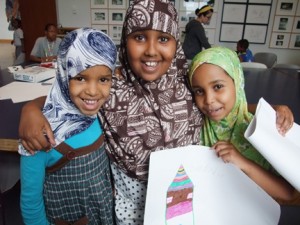It is impossible to talk about Somali identity without considering the Somali diaspora of recent years. According to the Global Initiative on Somali Refugees, there are approximately one million Somalis living abroad. This figure assumes a particular relevance to the study of Somali identity in that it cannot only be defined in terms of statehood, but which considers the entire Somali population, estimated to be around 10 million within its borders. If we are to examine a Somali national consciousness, which stretches beyond geographical borders along with the existence of a Somali consciousness within the country’s borders, it is first worth mentioning the existence of a strong sense of ‘Somaliness’ among the members of the Somali community who are living abroad.
The colonial divisions of the past are still ever present in Somalian society. Colonialism had given birth to a fragmented state divided into federal regions — each with its own local and fragile authority. The colonial experience within which modern Somali nationalism has developed should be considered in the context of an analysis of the country’s modern identity. A common consciousness stems from an awareness of the division of the colonial past. Along with the sense of nationhood, Somalis consider themselves strongly bound to each other by the common experiences of the language, the religion of Islam, and the nomadic pastoral culture. It is not a sense of state that provides Somali society with a specific group identity—there is no tradition in this sense—rather, the sense of Somali identity is based on ‘a long-standing sense of cultural uniqueness’.
Kinship lineages is the force that unites and binds the society together and within which the individual and social identity of the population must also be collocated, along with the adherence to Islam. Somali citizenship stresses the blood relationship between all Somalis; indeed, it is based on the concept of belonging to a family, group or clan . Specifically, clan identity represents within Somali society the foundation of their national identity.
However, a different discourse concerns the Somali diaspora youth and their perception of national identity. Over the past few decades the country has experienced territorial conflicts and political turmoil, where thousands of young Somalis have fled to different parts of the world. Ethiopian troops, with U.S. support, invaded Somalia in 2006 with the aim of ousting the Islamic Courts Union (ICU). The current government, supported by the international community, is weaker than it was in 2006, and vast parts of the country’s territory are controlled by al-Shabaab, an extreme al-Quaeda linked Islamist group accused of being more violent than ICU ever was.
Despite the fact that Somalia was accustomed to significant waves of migration over the centuries, the most impressive flow of migrants occurred after the collapse of the government in 1991. Since then, the despotism of the warlords, the controversial presence of al-Shabaab, the frequent interference of the international community, as well as the 2006 Ethiopian occupation, all contributed to worsen an already-unsafe environment and forced people to flee their homes in search of their fortunes abroad, in Middle Eastern countries, Western Europe, the U.S. and Canada. In particular, the long experience of ‘statelessness’ has had an impact on the youth of Somali diaspora. Worth mentioning is the impact of the Ethiopian occupation of Mogadishu coupled with the Western ‘War on Terror’ since 2001, and the risk of becoming a target of violence.
According to Khadra Elmi, a Somali researcher and traveller, the issue of identity requires a different approach that examines the impact of the Somali diaspora on young refugees and the generation born, raised and educated in Western schools overseas. If the older generation of Somali migrants reconfirmed their social identity in terms of clanship, in the case of the younger Somali generation, the process involves different elements. The capacity of the youngest to establish a link with their culture of belonging, even if abstract, resides in their relation to parents and friends and is strongly linked to the country where they have resettled. The comprehension of ‘self’ and ‘other’ is determined by their history of mobility and is shaped by the relation they have with the new environment. The way in which this primary network deals with the concept of identity affects the image they have of their uniqueness.
Nonetheless, Muslim identity is the element which underlies the perception of individuality. The reaffirmation of Islamic values through a strong relation with religion is a basic element in the self-representation of the younger Somali generation of migrants and for the new generation born in exile. In a context in which the core values of their culture are called into question, individuals’ natural reaction is to ‘extremize’ its more controversial aspects. According to Elmi, this underlies the strong self-identification with Muslim culture in the understanding and shaping of their Somali identity for young Somalis abroad.
I. M. Lewis, Visible and Invisible Differences: The Somali Paradox, Africa, 74 (4), 2004
K. Elmi, Distant Voices and the ties that bind: Identity, Politics and Somali Diaspora Youth, Accord, Issue 21, 2010
M. V. Hoehne, Political Representation in Somalia: Citizenship, clanism and territoriality, Accord, Issue 21, 2010
Article written by Sabella Festa Campanile
For more on the topic of Somali ethnicity and nationalism, please check out the following article published in SEN:
Journal:http://onlinelibrary.wiley.com/doi/10.1111/j.1754-9469.2011.01103.x/abstract

